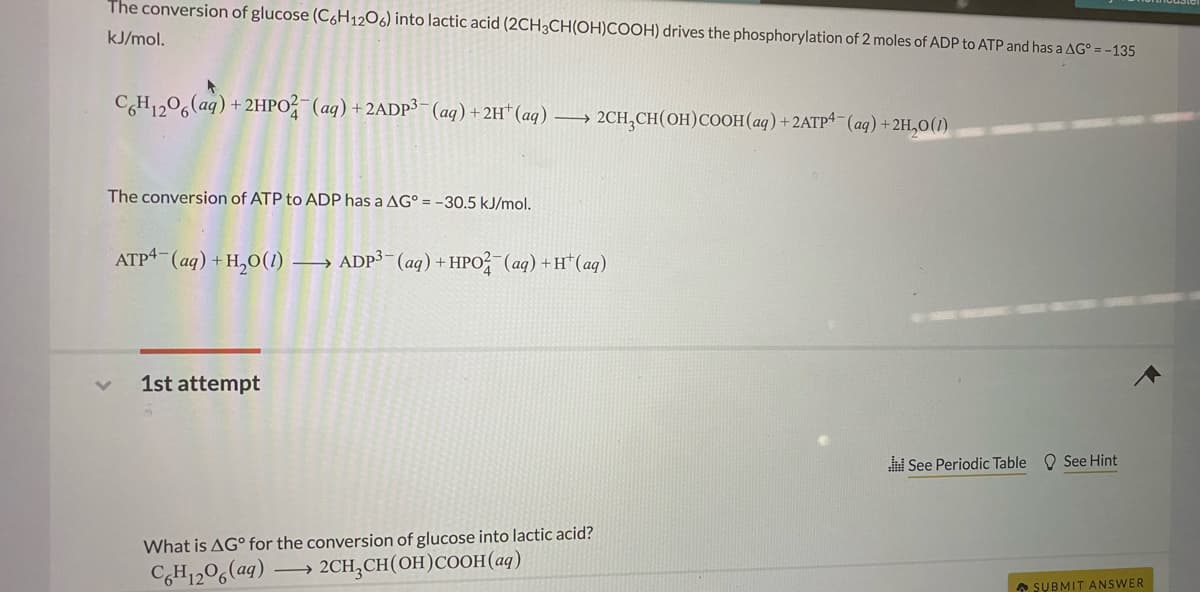The conversion of glucose (C6H12O6) into lactic acid (2CH3CH(OH)COOH) drives the phosphorylation of 2 moles of ADP to ATP and has a AG° =-135 kJ/mol. + 2HPO? (aq) + 2ADP³ - (aq) + 2H* (aq) → 2CH,CH(OH)COOH(aq) + 2ATPª-(ag) +2H,0(1) The conversion of ATP to ADP has a AG° = -30.5 kJ/mol. ATP4 (ag) + H,0(1) ADP³-(aq) + HPO (aq) +H*(aq) 1st attempt See Periodic Table O See Hint What is AG° for the conversion of glucose into lactic acid? → 2CH,CH(OH)COOH(aq) C,H,0, (aq)
The conversion of glucose (C6H12O6) into lactic acid (2CH3CH(OH)COOH) drives the phosphorylation of 2 moles of ADP to ATP and has a AG° =-135 kJ/mol. + 2HPO? (aq) + 2ADP³ - (aq) + 2H* (aq) → 2CH,CH(OH)COOH(aq) + 2ATPª-(ag) +2H,0(1) The conversion of ATP to ADP has a AG° = -30.5 kJ/mol. ATP4 (ag) + H,0(1) ADP³-(aq) + HPO (aq) +H*(aq) 1st attempt See Periodic Table O See Hint What is AG° for the conversion of glucose into lactic acid? → 2CH,CH(OH)COOH(aq) C,H,0, (aq)
Chemistry: The Molecular Science
5th Edition
ISBN:9781285199047
Author:John W. Moore, Conrad L. Stanitski
Publisher:John W. Moore, Conrad L. Stanitski
Chapter16: Thermodynamics: Directionality Of Chemical Reactions
Section: Chapter Questions
Problem 83QRT: Another step in the metabolism of glucose, which occurs after the formation of glucose6-phosphate,...
Related questions
Question

Transcribed Image Text:The conversion of glucose (C,H12O6) into lactic acid (2CH3CH(OH)COOH) drives the phosphorylation of 2 moles of ADP to ATP and has a AG° = -135
kJ/mol.
CH,0,(aq) + 2HPO? (aq) + 2ADP³3- (aq) +2H*(aq) –→ 2CH,CH(OH)COOH(aq) +2ATPª¯(ag) + 2H,0(1)
The conversion of ATP to ADP has a AG° = -30.5 kJ/mol.
ATP4 (ag)+H,0(1) –→ ADP³-(aq) + HPO? (aq) + H*(aq)
1st attempt
See Periodic Tabl
O See Hint
What is AG° for the conversion of glucose into lactic acid?
CH1206(aq)
→ 2CH,CH(OH)COOH(aq)
A SUBMIT ANSWER
Expert Solution
This question has been solved!
Explore an expertly crafted, step-by-step solution for a thorough understanding of key concepts.
This is a popular solution!
Trending now
This is a popular solution!
Step by step
Solved in 2 steps with 1 images

Knowledge Booster
Learn more about
Need a deep-dive on the concept behind this application? Look no further. Learn more about this topic, chemistry and related others by exploring similar questions and additional content below.Recommended textbooks for you

Chemistry: The Molecular Science
Chemistry
ISBN:
9781285199047
Author:
John W. Moore, Conrad L. Stanitski
Publisher:
Cengage Learning

Chemistry & Chemical Reactivity
Chemistry
ISBN:
9781337399074
Author:
John C. Kotz, Paul M. Treichel, John Townsend, David Treichel
Publisher:
Cengage Learning

Chemistry & Chemical Reactivity
Chemistry
ISBN:
9781133949640
Author:
John C. Kotz, Paul M. Treichel, John Townsend, David Treichel
Publisher:
Cengage Learning

Chemistry: The Molecular Science
Chemistry
ISBN:
9781285199047
Author:
John W. Moore, Conrad L. Stanitski
Publisher:
Cengage Learning

Chemistry & Chemical Reactivity
Chemistry
ISBN:
9781337399074
Author:
John C. Kotz, Paul M. Treichel, John Townsend, David Treichel
Publisher:
Cengage Learning

Chemistry & Chemical Reactivity
Chemistry
ISBN:
9781133949640
Author:
John C. Kotz, Paul M. Treichel, John Townsend, David Treichel
Publisher:
Cengage Learning

Chemistry: Principles and Reactions
Chemistry
ISBN:
9781305079373
Author:
William L. Masterton, Cecile N. Hurley
Publisher:
Cengage Learning

Chemistry for Engineering Students
Chemistry
ISBN:
9781337398909
Author:
Lawrence S. Brown, Tom Holme
Publisher:
Cengage Learning
